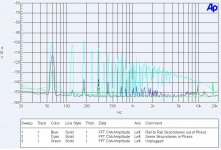Ahh yes, I calculated for audio, but 55V/uS hits the stops just above 4MHz, hence the lower BW.
Silly me!
To my defense: I just checked out my high-voltage regulator for my direct-drive ESL amp. In goes 2300V, out comes 2150V, rock stable.
Now I need some 20k, 200W load rsistors...
Jan
200watt ...!
Same thing. Under constant load from both rails the ripple will always be symmetric with a full wave rectifier. However under a normal load where more power is drawn from one rail for a period less than the AC lines, you will see asymmetric ripple.
Not so fast Ed.
How do you change that into 'less asymmetric' by swapping a secondary? The asymmetry is caused by your postulating asymetric power draw.
Jan
Last edited:
200watt ...!
That's for two channels. I'm aiming at 1500VRMS at 100mARMS per channel into purely capacitive load.

So I'm missing the difference in why the reversal of one of these two secondary windings would matter.
I think that the answer is in these two posts:
Ed, how perfect is the symmetry of stray capacitances?
Using a bifilar wound transformer, better than 20 dB of noise reduction.
Capacitive coupling from primaries to secondaries is in antiphase with this arrangement, thus diminishing any capacitive common mode output.
George
Ed, would you mind posting measurements to show EMI suppression?
I will see if I can find them since I changed computers it will be a bit of a bother. But I did post the results here a bit back.
Not so fast Ed.
How do you change that into 'less asymmetric' by swapping a secondary? The asymmetry is caused by your postulating asymetric power draw.
Jan
You can look at the scope shots when I finish and sell the power supply article.
I think that the answer is in these two posts:
Capacitive coupling from primaries to secondaries is in antiphase with this arrangement, thus diminishing any capacitive common mode output.
George
The close coupling increases the common mode capacitive coupling which may be a bigger issue. The common mode noise will come through the capacitive coupling between the elements of the transformer. At 1 MHz+ how its wound won't matter. Think of the noise source as a high impedance current source. A shield can be used to shunt the noise currents back to the source if you have a path for them. A double shielded transformer can work real well if you can return the shields to good places. The safety ground may not be useful. You will also sacrifice transformer efficiency.
While not significant for low voltage, using a bifiliar winding brings issues of voltages between the two conductors and they could have the peak voltage between them which may not be a good thing in high voltage applications.
You can't use a bifilar winding for a primary to secondary if there is a voltage difference notwithstanding the voltage isolation requirements between the primary and secondary.
However it is my opinion that in a solid state amplifier it is the line noise reduction that is the dominant improvement.
1) If an amp's performance is seriously affected by line noise my view is that the PSU is not designed very well.
2) If an amp is affected by line noise it will probably also be affected by diode switching noise - seems more logical to clean up after the diodes.
3) The other thing to think about is just how much a power amp PSU action is adding to line noise.
Thanks Ed, we can see the cancelation from the out of phase secondary's. Some my want to think of it like the "Push - Pull" action of an output stage in a amplifier. I can't post pictures, but how about this,
+ rail ripple mmmmmm
- rail ripple uuuuuuuuu
This would be with the secondary's out of phase. I think that some readers are focusing on only the DC aspect of the power supply, and the idea is to think of the AC part (ripple) being placed out of phase with each other. With a CT supply it happens due to the design, and we don't have to worry about it. But with two secondary's we have to make sure that the connections to the two diode bridges produce ripple that is out of phase with each other.
+ rail ripple mmmmmm
- rail ripple uuuuuuuuu
This would be with the secondary's out of phase. I think that some readers are focusing on only the DC aspect of the power supply, and the idea is to think of the AC part (ripple) being placed out of phase with each other. With a CT supply it happens due to the design, and we don't have to worry about it. But with two secondary's we have to make sure that the connections to the two diode bridges produce ripple that is out of phase with each other.
Pavel I found it.
That is significant.
I think NP also mentions this somewhere as well. He is also a proponent of rectifying and regulating separately before combining to make s split supply.
Any measurements with standard, non bifilar wound transformer?
I do not expect a primary to be wound with a secondary. I expect in any modern transformer for there to be an extra layer of insulation on the core and between the primaries and secondaries.
most of today's EI traffos use nylon plastic bobbins and with at least two vertical bays for easy winding, the primary coils on one side and secondaries on another...
Demian
My post was close in meaning to Ed’s post (he is after conium ):
):
Your post discusses the innards of the transformer.
At 1MHz+ it is the interaction of leakage inductance btn prim-sec and the winding capacitance that rules (the impedance and response dips and peaks are horrible at VHF,UHF).
In general, low leakage inductance (say through bifilar winding) attain to push the resonance very high in freq.
But I’ve read (*) of deliberately designing for high leakage inductance which in combination with the inherent winding capacitance plus an added shunt cap, form a pi low pass filter for reducing the coupled RF noise.
If the load impedance is made low at high frequencies, the interlayer shield may not be needed.
The efficiency of a single and a double shield will greatly depend on the constructional symmetry –thus capacitive coupling symmetry- btn windings and shields. By symmetrically splitting the bobbins or using bifilar winding, shield currents are reduced.
How (why)?
Yes, primary to secondary for solid state equipment. For tubes, this problem is met at the centered tapped secondary as well.
Thank you
George
(*) In an excellent book: http://leonaudio.com.au/microphone.engineering.handbook..chapter.8.pdf
My post was close in meaning to Ed’s post (he is after conium
Your post discusses the innards of the transformer.
The close coupling increases the common mode capacitive coupling which may be a bigger issue. The common mode noise will come through the capacitive coupling between the elements of the transformer. At 1 MHz+ how its wound won't matter.
At 1MHz+ it is the interaction of leakage inductance btn prim-sec and the winding capacitance that rules (the impedance and response dips and peaks are horrible at VHF,UHF).
In general, low leakage inductance (say through bifilar winding) attain to push the resonance very high in freq.
But I’ve read (*) of deliberately designing for high leakage inductance which in combination with the inherent winding capacitance plus an added shunt cap, form a pi low pass filter for reducing the coupled RF noise.
Think of the noise source as a high impedance current source. A shield can be used to shunt the noise currents back to the source if you have a path for them. A double shielded transformer can work real well if you can return the shields to good places.
If the load impedance is made low at high frequencies, the interlayer shield may not be needed.
The efficiency of a single and a double shield will greatly depend on the constructional symmetry –thus capacitive coupling symmetry- btn windings and shields. By symmetrically splitting the bobbins or using bifilar winding, shield currents are reduced.
You will also sacrifice transformer efficiency.
How (why)?
You can't use a bifilar winding for a primary to secondary if there is a voltage difference notwithstanding the voltage isolation requirements between the primary and secondary.
Yes, primary to secondary for solid state equipment. For tubes, this problem is met at the centered tapped secondary as well.
Thank you
George
(*) In an excellent book: http://leonaudio.com.au/microphone.engineering.handbook..chapter.8.pdf
Last edited:
While not significant for low voltage, using a bifiliar winding brings issues of voltages between the two conductors and they could have the peak voltage between them which may not be a good thing in high voltage applications.
You can't use a bifilar winding for a primary to secondary if there is a voltage difference notwithstanding the voltage isolation requirements between the primary and secondary.
oh, but i have done this on an isolation transformer build....
the traffo is still alive and in service till this day, at the time i built it,
two bay bobbins were not yet available where i live.....

I think NP also mentions this somewhere as well. He is also a proponent
of rectifying and regulating separately before combining to make a split supply.
I do this to prevent noise from the transformer.
When a center-tapped transformer and single bridge supply see net DC or low
frequency AC through the center tap, any mismatch in the secondary windings
will tend to saturate the core, causing mechanical and radiated magnetic noise.
- Status
- Not open for further replies.
- Home
- Member Areas
- The Lounge
- John Curl's Blowtorch preamplifier part II
